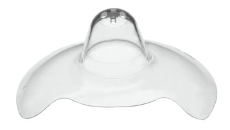Walk down the breastfeeding aisle of any superstore, and you’ll see products that you likely didn’t know existed, at least before you entered BreastfeedingLand. Nursing covers, nursing stools, nursing shirts. Breast pads (disposable or reusable) and little towelettes to clean your nipples after a feeding. And Boppies. So.many.Boppies. These products are all optional; you can use them or not, as fits your personality and your lifestyle, and they probably won’t make too much difference in your nursing relationship.
But there’s one nursing accessory that’s different: Nipple shields. These thin pieces of silicone that fit over your nipples can have a huge impact on your nursing relationship, sometimes for the better and sometimes for the worse.
I’ve written before about my nursing relationship with my son, now 4 and weaned. We had a rough start with breastfeeding, and I had cracked, sore nipples after a week or so. The visiting nurse from the health department gave me a nipple shield at our first appointment; it eased the pain a little, but it didn’t solve the problem. In fact, things got worse; after a week nursing with the shield, Will had actually lost weight.
I was determined to make nursing work, so I met with a private lactation consultant. She got me a correctly sized shield (the visiting nurse had never mentioned this was an option) and she worked with me for a few months to help Will become a more efficient nurser and take in more milk at a time. Eventually, we were able to stop using the shield when he was about 4 months old, and from then on things were much easier.

I firmly believe that if it hadn’t been for the shield, I’d have given up nursing due to the pain. So in a way the shield was a lifesaver, because it was very important to me to breastfeed if at all possible. But in another way … it was a total pain in the neck. To put it nicely. And I’m well aware that if it hadn’t been for that lactation consultant, Will wouldn’t have gained weight fast enough, so I’d have given up nursing then, too — and blamed myself for not producing enough milk.
So, my nursing journey is done — why am I telling you all this? Because I think moms are often handed a little packet of silicone and not told what effect it could have on their nursing relationship. I’ve even seen some women put nipple shields on their baby registries, assuming before they even begin nursing that it’ll be painful.
As I experienced, nipple shields can be helpful. I’m glad the shield was available to me, and I’d use it again if I experienced nipple pain while nursing. But they can also complicate matters, and I wish I’d known about some of those in advance. So here’s my list of the pros and cons of nipple shields — and a partial list of local resources if you want to talk to a lactation professional about how to use a shield effectively.
Pros of Nipple Shields
They can reduce pain and help injured nipples heal.
This is the reason most women end up using a nipple shield. Their nipples are sore, raw or cracked, making each nursing session agony. A shield takes a bit of the pressure off sore nipples, which makes nursing sessions easier; and without that constant stimulation, your nipples can heal more easily. You still may feel a pinching sensation while nursing, but it’s less painful than the burning ow-ow-OW! you felt before.
They can help women with flat or inverted nipples nurse.
They can help babies latch onto an engorged breast.
They can help babies with physical challenges such as tiny mouths or impaired suckling mechanisms.
Cons of Nipple Shields
They won’t fix the root problem.
If you’re experiencing pain due to a bad latch (when your baby nurses in a way that your nipple rubs painfully against the inside of her mouth), a nipple shield won’t fix that. I found that things got worse for a bit; my son sucked harder to try to get milk out of this strange, smooth nipple, and he put even more pressure on my sore nipples. Once I began working with a lactation consultant, we were able to improve the latch and the pain went away.
They may keep your baby from getting as much milk as possible.
Breastfeeding is a supply-and-demand proposition: The more stimulation your breasts get, the more milk they make. So when you use a nipple shield, your baby’s suckling stimulates your breast less than it otherwise would. Less stimulation = less milk. Depending on how often your baby nurses, and for how long, this can lead to slow weight gain — or in Will’s case, weight loss. It doesn’t always — many women use a shield for months and their babies are perfectly happy and healthy. But I’d advise paying attention to your baby’s weight and her diaper output, until you and your providers feel confident that she’s gaining well.
They take some getting used to.
Most of the time when a mom starts using a nipple shield, it’s during the first few weeks of nursing, when everything is new and confusing to begin with. And a shield is just one more thing to learn. You have to figure out how to get the thing to stick to your nipple, how to position it, how to clean it, how to store it between nursing sessions. It’s a complication that, frankly, I would rather have done without.
If you forget it, you’re sunk.
Halloween 2010. I was at a friend’s house with Will, nearly 3 months old. He was hungry, so I felt in my diaper bag for the little Tupperware box I kept the shield in. It wasn’t there. Instantly I knew where it was: on the end table in my living room. So there was nothing to do but offer Will my bare breast. He was not happy about it. After plenty of screaming, he eventually took enough milk to satisfy him for a while. But it taught me a valuable lesson: If you’re going to depend on a nipple shield, get two. At least.
Once you start using a shield, it’s hard to stop.
You start using a shield, your nipples heal, and you’re ready stop using it. Problem is, your baby’s not. Babies are creatures of habit; they get used to the smooth, elongated nipple on the shield, and the real thing isn’t always acceptable. This may not be a problem; plenty of women nurse with a shield for a long time. But I was itching to get rid of the thing and nurse on my bare nipple. (Now there’s a phrase I never thought I’d type.) It took several months and plenty of attempts, but Will eventually was able to nurse without the shield at about 4 months.
Getting Support
If you use a nipple shield, I would advise you to work with a lactation consultant to make sure your baby is growing well and getting all the milk he needs. A consultant can help you and your baby learn to nurse without the shield, if you want; or she can confirm that things are going well with the shield.
Many pediatrician’s offices have a lactation consultant on staff; you can see one in private practice; or you can go through the hospital or birth center where you delivered.
Here are the hospital-based and private-practice lactation services in the Midlands that I know of:
- All the Best offers in-home and office visits: (803) 479-2327
- Lexington Medical Center‘s new parent hotline can help with breastfeeding questions and other topics: (803) 791-2525
- Palmetto Health has a variety of lactation services:
- Lactation helplines: Palmetto Health Richland, (803) 434-6541; Palmetto Health Baptist, (803) 296-8426
- Lactation boutiques, selling nursing bras and breast pumps: Palmetto Health Richland, (803) 434-3577; Palmetto Health Baptist, (803) 296-2372; Palmetto Health Parkridge, opening soon
- Breastfeeding support group, meets 1st and 3rd Monday from 10 a.m. to 11 a.m. at Palmetto Health Children’s Hospital. Register by calling (803) 296-CARE.
- WIC offices throughout the Midlands offer breastfeeding support.
Another local resource is La Leche League, a group of nursing moms mentoring nursing moms. La Leche has chapters across the state, including one in the Midlands.
Do you use a nipple shield when nursing your baby? Share your story in the comments.













One key point I’d love to be added is that sometimes a baby that needs a nipple shield may actually have a lip and/or tongue tie as the root problem. Unless there are obvious other reasons, please check into lip and tongue ties if you are finding that baby needs a nipple shield.